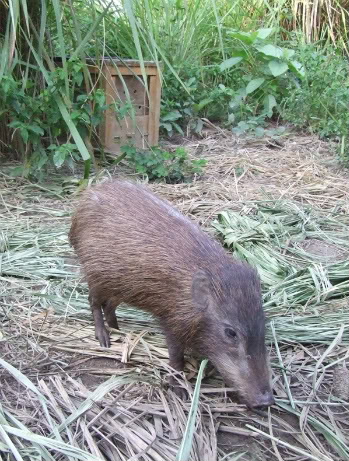|
|
The critically-endangered pygmy hog Porcula salvania (also known as Sus salvanius) is thriving one year after being reintroduced into Sonai Rupai Wildlife Sanctuary in Assam, India.
According to researchers with the Durrell Wildlife Conservation Trust (DWCT), surveys and camera traps have shown that two-thirds of the 16 originally released pygmy hogs have survived their first year. One of two pregnant females gave birth successfully with tracks of baby pygmy hogs found in the summer of last year.
 The world’s smallest and rarest wild pig: the pygmy hog. Photo by: Goutam Narayan / Durrell Wildlife Conservation Trust. |
Pygmy hogs have the honor of being the world’s smallest wild pig, standing between 20 and 30 centimeters off the ground. The hog’s natural habitat is grasslands which have been increasingly cultivated by humans. The species remains threatened by agricultural expansion, livestock, burning of the grasslands, and the commercial forestry industry. The vanishing grasslands are important to several other species including the swamp deer Cervus duvauceli, wild buffalo Bubalus bubalis, hispid hare Caprolagus hispidus, and Bengal florican Houbaropsis bengalensis.
The Pygmy Hog Conservation Program (PHCP), which oversaw the reintroduction, is planning a second release of 14 more pygmy hogs this month. The pygmy hogs have been preparing for their release since last December in special pens. Currently the breeding facility for this critically-endangered species has a total of 41 adults.
“The successful establishment of new populations of this species is the culmination of the hard work of a number of organizations to save this animal from extinction, and the survival of the first batch of pigs bodes well for the future,” said John Fa, John Fa, Director of Conservation Science at Durrell.
The pygmy hog was featured on the popular program Planet Earth.
Related articles
Vital corridor for Asian elephants to be severed by government development in India
(04/05/2009) The largest wild population of Asian elephants in the world is threatened by development over a 2.5 kilometer wide corridor, according to Rainforest Information Centre which is apart of an international campaign to change the location of the development. The corridor, located in the Western Ghats of India, is the last unbroken forest leading the elephants from wet season to dry season feeding grounds. Unfortunately the corridor also connects two different Indian states: Kerala and Karnataka.
12 new species of frogs discovered in India
(02/03/2009) A dozen previously unknown species of frogs have been discovered in the forests of Western Ghats according to a paper published in latest issue of Zoological Journal of Linnean Society, London. The 12 species have been identified following a revision of the Philautus genus and are the result of ten years of field study in Kerala, Tamil Nadu, Karnataka. Goa, Maharashtra, and part of Gujarat, in the Western Ghats. The Western Ghats are considered a global biodiversity hotspot for their species richness and the threats the mountain range faces.
Rainforest agriculture preserves bird biodiversity in India
(11/04/2008) Conservation of biodiversity and agriculture have long been considered conflicting interests. Numerous studies have shown that when agricultural replaces a forest, biodiversity greatly suffers. However a new study finds it doesn't have to be that way.